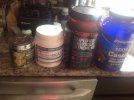I started lifting at age 52. I am now 67. Let me tell you right off, that well meaning advice from young people is all about what works for them. You and I are not them.
We do not recover from workouts nearly as fast as they do.
We are more susceptible to repetitive motion injuries.
We likely have accumulated a condition or two over the years that we must accommodate. (Mine is a bad back and rotator cuff trouble, both pre-existing the weight training.)
I know from first-hand experience that over-50 men can make impressive strength and muscle gains lifting one day a week, one set only of each exercise, 6 to 12 reps to failure with each exercise, limiting total workout time to no more than an hour, with 45 minutes being better. Furthermore, I used a three-routine split, back/shoulders, chest/abs, and legs. It is absolutely possible to increase strength and muscle mass doing any given exercise one time once every three weeks, because I have done it
I started out exercising every four days, but as advancing age made recovery time longer, I eventually went to the once per week route.
ABSOLUTELY! I'm 30 and 6'0 223lbs. I use the HIT or High Intensity Training method. I know a lot of people will preach about high volume and high reps, but it really comes down to science. You stimulate the muscle in the gym, but growth can not occur until recovery of said muscle is complete. The way I see it, most sports related injuries and similar issues are due to OVERTRAINING. You cannot go to the gym 4-5 times a week and do 12-15 sets per body part. Someone just starting out will make muscular gains on a routine like this, but will eventually plateau and their body will adapt. The factors of HIT are: low training volume, brief and intense workouts, low frequency, and slow controlled muscular contractions that allow full range of movement. If you do not increase your weight and or reps on a given type of exercise each time you go to the gym, you are overtrained.
I currently lift on Mondays and Thursdays. It is broken down into 3 workouts:
Monday - Flat dumbbell flys 1 set of 8-10 reps
Immediately followed by
-Flat or incline dumbbell press 1 of set 6-10 reps
Immediately followed by
- Dips 2 sets to failure.
Rest 2-3minutes
- Tricep pushdowns 1 set of 8-10 reps
Immediately followed by
- Barbell bicep curls 1 set of 8-10 reps
Immediately followed by
- Standing dumbbell curls 1 set of 6-8
WORKOUT COMPLETE
Thursday - Deadlifts 2 sets of 4-8 reps
Immediately followed by
- Low rows 1 set of 8-10
Immediately followed by
- Barbell rows 1 set of 6-8
Rest 2-3 minutes
- Dumbbell shrugs 1 set of 10-12
Immediately followed
- Seated dumbbell shoulder press 2 sets of 6-10
Immediately followed by
- Standing side raises 1 set of 6-10
WORKOUT COMPLETE
Monday - Leg extensions 1 set of 10-12 reps
Immediately followed by
- Back Squats 1 set of 6-8 reps
Immediately followed by
- Front squats 1 set of 6-8 reps
Immediately followed by
- Leg press 1 set of 10-12
Rest 2-3 minutes
- Standing calf raises 2 sets of 6-10 reps
Immediately followed by
- Seated calf raises 1 set of 8-10 reps.
WORKOUT COMPLETE
I never spend more than 30min at the gym. It's an hour per week.
Deadlifts- 405lbs
Squat-365lbs
Dips- 4 reps with 100lb plate around the waist
No supplements or drugs.
Anyone can do this and succeed. Hope this helps.
Mike

